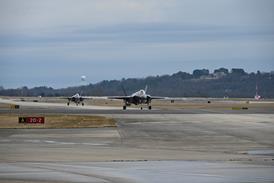Lockheed Martin and Sikorsky teams tackle key criticisms
The competition to replace the US presidential helicopter (VXX) fleet is intensifying as both contenders unveil design changes and clarify portions of their bids.
Sikorsky has tackled a key criticism of the VH-92 Super Hawk's smaller interior by lengthening the aircraft's cabin by 1.44m (4.75ft) to 7.54m and increasing its internal volume to 26.1m3 (920ft3). The modification - conceived within the last four months - uses space formerly occupied by the aft ramp mechanism, which has been removed. The extension also allows Sikorsky to add an aft-left exit door.
The Lockheed Martin-led US101 team has responded with a similar modification. Cabin length of the AgustaWestland EH101-based aircraft has been extended by 1.22m to 7.75m, says Lockheed Martin US101 vice-president Stephen Ramsey. The design change also uses the aircraft's aft ramp area, which has been converted to storage space. However, the US101's ramp remains operational, says Ramsey. Overall interior cabin space now measures 35.2m3, or about 25% more than the VH-92.
Sikorsky touted other design changes, such as an enhanced active vibration control (AVC) system on the VH-92. The AVC is improved by increasing the number of force generators used to counter vibration levels, but Sikorsky declines to provide further details. The US101 cancels vibrations using an active control structural response system.
Nick Lappos, Sikorsky's VXX programme director, says the VH-92 is also easier to deploy. The US101's main rotor assembly, he says, must be removed to travel aboard the Lockheed C-5 Galaxy transport, whereas the smaller VH-92 can be rolled on intact, although a required blade-folding kit is still in development. AgustaWestland says the US101 can be returned to flight condition within 3h.
The US101 team, including Bell Helicopter and AgustaWestland, has added Northrop Grumman and ITT as major partners supplying "special mission equipment". Northrop Grumman makes the directional infrared countermeasures system and ITT produces the suite of radio- frequency integrated counter-measures.
The Lockheed Martin-led team now includes about 200 US suppliers, but the company has not disclosed the number of offshore suppliers supporting its bid. At least 65% of the manufacturing work and 90% of the life-cycle maintenance costs will go to US companies if the type is selected.
The navy is expected to award the contract for 23 aircraft by May.
STEPHEN TRIMBLE / WASHINGTON DC
Source: Flight International























